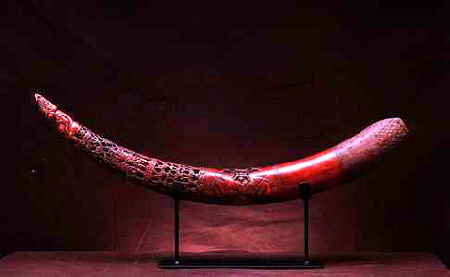Galerie Peter Herrmann
|
 |
Transverse Horn Brownish red patina through preservation with palm oil. Mounted figure. Buffaloes' heads and lizards carved in open work, circulating reliefs depicting animals and people, richly ornamented. 18th/19th century. 128 cm. Archive PM 87/018 ( all Papers, Import-, Cites- etc. ) In many cultures of Western or Central Africa local rulers and kings used to be accompanied to receptions, official events, council meetings or war campaigns by horn-playing heralds. In rural areas these heralds played on wooden transverse oliphants/horns, whereas in royal cultures it was a priviledge and a status symbol to use ivory ones. For the first time objects of this kind were introduced in Europe by the Portuguese in the 15th and 16th century. Impressed by the quality of the carving they ordered first commissioned works in ivory mainly from Nigeria and Angola. Heralds' and magnificent oliphants/horns from the grasslands of Cameroun were not known before 1900 when in the course of colonization this until then mainly unknown region was explored by the Germans. The most famous photographic documents come from King Njoija's court, Sultan of Foumban. His splendid throne, a present to the German Emperor, is now exhibited in the Völkerkundemuseum Berlin. In front of his throne lay two enormous ivory tusks which emphasized his importance and influence. After numerous mass migrations in the grasslands mainly the Tikar, the Bamileke and the Bamoun have succeeded as autonomous cultures during the last 300 years. Today their area is seen as one of the culturally richest in Africa. Whereas it is possible to notice distinctive differences amongst statues and masks of these peoples, this is not necessarily the case in the field of the shown transverse horns. According to a vivid exchange renowned carvers travelled or received orders from rulers of other areas, thus stilistic traits become undefinable. Many depictions of mythological symbols such as the spider, the double-headed snake or the double bell are nowadays largely attributed to the Bamoun but can also be found on old exhibits of the other mentioned peoples. Authentically African objects have proved the most stable prices amongst the art market of this century. This indicates that the shown heralds' horns have additionally to their artistic value the highest security factor as an investment object. The depicted heralds' oliphants are absolutely in a top condition. sold 1992 |
| Similar objects : | Illustration: |
| Stuttgart. Lindenmusem |
| Rijksmuseum Volkenkunde. Leiden, NL. |
|
|